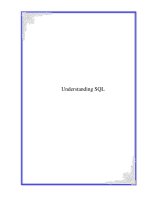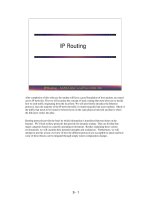Tài liệu Microcontroller 8051 ppt
Bạn đang xem bản rút gọn của tài liệu. Xem và tải ngay bản đầy đủ của tài liệu tại đây (330.72 KB, 63 trang )
1
2
Why do we need to learn Microprocessors/controllers?
•
The microprocessor is the core of computer systems.
•
Nowadays many communication, digital
entertainment, portable devices, are controlled by
them.
•
A designer should know what types of components he
needs, ways to reduce production costs and product
reliable.
3
Different aspects of a microprocessor/controller
•
Hardware :Interface to the real world
•
Software :order how to deal with inputs
4
The necessary tools for a microprocessor/controller
•
CPU: Central Processing Unit
•
I/O: Input /Output
•
Bus: Address bus & Data bus
•
Memory: RAM & ROM
•
Timer
•
Interrupt
•
Serial Port
•
Parallel Port
5
CPU
General-
Purpose
Micro-
processor
RAM ROM
I/O
Port
Timer
Serial
COM
Port
Data Bus
Address Bus
General-Purpose Microprocessor System
Microprocessors:
•
CPU for Computers
•
No RAM, ROM, I/O on CPU chip itself
•
Example : Intel’s x86, Motorola’s 680x0
Many chips on mother’s board
General-purpose microprocessor
6
RAM ROM
I/O
Port
Timer
Serial
COM
Port
Microcontroller
CPU
•
A smaller computer
•
On-chip RAM, ROM, I/O ports
•
Example : Motorola’s 6811, Intel’s 8051, Zilog’s Z8 and PIC 16X
A single chip
Microcontroller :
7
Microprocessor
•
CPU is stand-alone, RAM,
ROM, I/O, timer are separate
•
designer can decide on the
amount of ROM, RAM and
I/O ports.
•
expansive
•
versatility
•
general-purpose
Microcontroller
•
CPU, RAM, ROM, I/O and
timer are all on a single chip
•
fix amount of on-chip ROM,
RAM, I/O ports
•
for applications in which cost,
power and space are critical
•
single-purpose
Microprocessor vs. Microcontroller
8
•
Embedded system means the processor is embedded into that
application.
•
An embedded product uses a microprocessor or microcontroller to do
one task only.
•
In an embedded system, there is only one application software that is
typically burned into ROM.
•
Example : printer, keyboard, video game player
Embedded System
9
1. meeting the computing needs of the task efficiently and cost
effectively
•
speed, the amount of ROM and RAM, the number of I/O ports and
timers, size, packaging, power consumption
•
easy to upgrade
•
cost per unit
2. availability of software development tools
•
assemblers, debuggers, C compilers, emulator, simulator, technical
support
3. wide availability and reliable sources of the microcontrollers.
Three criteria in Choosing a Microcontroller
10
Block Diagram
CPU
On-chip
RAM
On-chip
ROM for
program
code
4 I/O Ports
Timer 0
Serial
Port
OSC
Interrupt
Control
External interrupts
Timer 1
Timer/Counter
Bus
Control
TxD RxD
P0 P1 P2 P3
Address/Data
Counter
Inputs
11
12
Pin Description of the 8051
1
2
3
4
5
6
7
8
9
10
11
12
13
14
15
16
17
18
19
20
40
39
38
37
36
35
34
33
32
31
30
29
28
27
26
25
24
23
22
21
P1.0
P1.1
P1.2
P1.3
P1.4
P1.5
P1.6
P1.7
RST
(RXD)P3.0
(TXD)P3.1
(T0)P3.4
(T1)P3.5
XTAL2
XTAL1
GND
(INT0)P3.2
(INT1)P3.3
(RD)P3.7
(WR)P3.6
Vcc
P0.0(AD0
)
P0.1(AD1)
P0.2(AD2
)
P0.3(AD3)
P0.4(AD4)
P0.5(AD5)
P0.6(AD6)
P0.7(AD7)
EA/VPP
ALE/PROG
PSEN
P2.7(A15)
P2.6(A14
)
P2.5(A13
)
P2.4(A12
)
P2.3(A11)
P2.2(A10)
P2.1(A9)
P2.0(A8)
8051
(8031)
13
Packing Types of 8051
•
The 8051 family members come in different packages, such
as DIP ( dual in-line package ) ,QFP ( quad flat
package ) and LLC ( leadless chip carrier ) .
–
See Appendix H ( Pages 427-429 )
•
They all have 40 pins.
•
Figure 4-1. 8051 Pin Diagram
14
8051 Pin Diagram
PDIP/Cerdip
1
2
3
4
5
6
7
8
9
10
11
12
13
14
15
16
17
18
19
20
40
39
38
37
36
35
34
33
32
31
30
29
28
27
26
25
24
23
22
21
P1.0
P1.1
P1.2
P1.3
P1.4
P1.5
P1.6
P1.7
RST
(RXD)P3.0
(TXD)P3.1
(T0)P3.4
(T1)P3.5
XTAL2
XTAL1
GND
(INT0)P3.2
(INT1)P3.3
(RD)P3.7
(WR)P3.6
Vcc
P0.0(AD0
)
P0.1(AD1)
P0.2(AD2
)
P0.3(AD3)
P0.4(AD4)
P0.5(AD5)
P0.6(AD6)
P0.7(AD7)
EA/VPP
ALE/PROG
PSEN
P2.7(A15)
P2.6(A14)
P2.5(A13)
P2.4(A12)
P2.3(A11)
P2.2(A10)
P2.1(A9)
P2.0(A8)
8051
(8031)
15
Pins of 8051 ( 1/4 )
•
Vcc ( pin 40 ):
–
Vcc provides supply voltage to the chip.
–
The voltage source is +5V.
•
GND ( pin 20 ): ground
•
XTAL1 and XTAL2 ( pins 19,18 ):
–
These 2 pins provide external clock.
–
Way 1 : using a quartz crystal oscillator
–
Way 2 : using a TTL oscillator
–
Example 4-1 shows the relationship between XTAL and
the machine cycle.
16
Pins of 8051 ( 2/4 )
•
RST ( pin 9 ): reset
–
It is an input pin and is active high ( normally low ) .
•
The high pulse must be high at least 2 machine cycles.
–
It is a power-on reset.
•
Upon applying a high pulse to RST, the microcontroller will reset
and all values in registers will be lost.
•
Reset values of some 8051 registers
–
Way 1 : Power-on reset circuit
–
Way 2 : Power-on reset with debounce
17
Pins of 8051 ( 3/4 )
•
/EA ( pin 31 ): external access
–
There is no on-chip ROM in 8031 and 8032 .
–
The /EA pin is connected to GND to indicate the code is
stored externally.
–
/PSEN & ALE are used for external ROM.
–
For 8051, /EA pin is connected to Vcc.
–
“/” means active low.
•
/PSEN ( pin 29 ): program store enable
–
This is an output pin and is connected to the OE pin of the
ROM.
–
See Chapter 14.
18
Pins of 8051 ( 4/4 )
•
ALE ( pin 30 ): address latch enable
–
It is an output pin and is active high.
–
8051 port 0 provides both address and data.
–
The ALE pin is used for de-multiplexing the address and
data by connecting to the G pin of the 74LS373 latch.
•
I/O port pins
–
The four ports P0, P1, P2, and P3.
–
Each port uses 8 pins.
–
All I/O pins are bi-directional.
19
Figure 4-2 (a). XTAL Connection to 8051
C2
30pF
C1
30pF
XTAL2
XTAL1
GND
•
Using a quartz crystal oscillator
•
We can observe the frequency on the XTAL2 pin.
20
Figure 4-2 (b). XTAL Connection to an
External Clock Source
NC
EXTERNAL
OSCILLATOR
SIGNAL
XTAL2
XTAL1
GND
•
Using a TTL oscillator
•
XTAL2 is unconnected.
21
Example 4-1
Find the machine cycle for
(a) XTAL = 11.0592 MHz
(b) XTAL = 16 MHz.
Solution:
(a) 11.0592 MHz / 12 = 921.6 kHz;
machine cycle = 1 / 921.6 kHz = 1.085 µs
(b) 16 MHz / 12 = 1.333 MHz;
machine cycle = 1 / 1.333 MHz = 0.75 µs
22
Table 4-1: RESET Value of Some 8051
Registers
0000DPTR
0007SP
0000PSW
0000B
0000ACC
0000PC
Reset ValueRegister
RAM are all zero.
23
Figure 4-3 (a). Power-On RESET Circuit
30 pF
30 pF
8.2 K
10 uF
+
Vcc
11.0592 MHz
EA/VPP
X1
X2
RST
31
19
18
9
24
Figure 4-3 (b). Power-On RESET with
Debounce
EA/VPP
X1
X2
RST
Vcc
10 uF
8.2 K
30 pF
9
31
25
Pins of I/O Port
•
The 8051 has four I/O ports
–
Port 0 ( pins 32-39 ): P0 ( P0.0 ~ P0.7 )
–
Port 1 ( pins 1-8 ): P1 ( P1.0 ~ P1.7 )
–
Port 2 ( pins 21-28 ): P2 ( P2.0 ~ P2.7 )
–
Port 3 ( pins 10-17 ): P3 ( P3.0 ~ P3.7 )
–
Each port has 8 pins.
•
Named P0.X ( X=0,1, ,7 ) , P1.X, P2.X, P3.X
•
Ex : P0.0 is the bit 0 ( LSB ) of P0
•
Ex : P0.7 is the bit 7 ( MSB ) of P0
•
These 8 bits form a byte.
•
Each port can be used as input or output (bi-direction).









